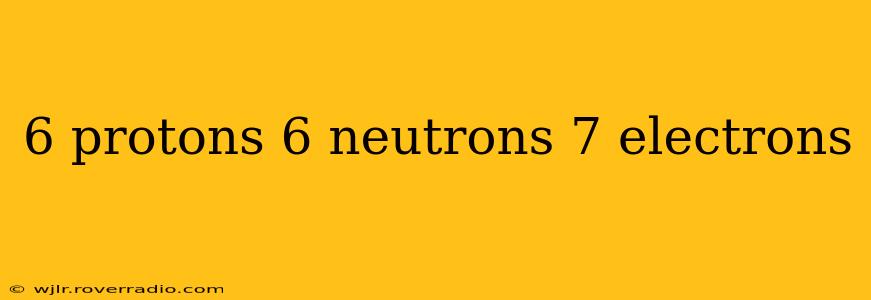6 Protons, 6 Neutrons, 7 Electrons: Understanding This Atomic Configuration
The description "6 protons, 6 neutrons, 7 electrons" points to a specific type of atom: a negatively charged ion of carbon. Let's break down what this means and explore related concepts.
What do the numbers represent?
-
Protons: The number of protons defines the element. Six protons always indicate the element carbon (C). Protons are positively charged particles found in the nucleus of an atom.
-
Neutrons: Neutrons, also located in the nucleus, are particles with no charge. The number of neutrons can vary within an element, creating different isotopes. In this case, six neutrons represent the most common isotope of carbon, Carbon-12 (¹²C).
-
Electrons: Electrons are negatively charged particles that orbit the nucleus. The number of electrons typically equals the number of protons in a neutral atom. However, in this case, there are seven electrons, one more than the number of protons. This surplus of negative charge makes this a negative ion, specifically a carbon anion.
What is an ion?
An ion is an atom or molecule that has gained or lost one or more electrons, giving it a net positive or negative charge. Ions are crucial in chemical reactions and biological processes.
How does a carbon atom become a negative ion?
Carbon atoms typically have four electrons in their outermost shell (valence shell). To achieve a stable electron configuration (a full outer shell), they can share electrons through covalent bonds or, less commonly, gain or lose electrons to form ions. In this instance, the carbon atom has gained an extra electron, resulting in a negative charge and creating the C⁻ ion (often written as ¹²C⁻ to specify the isotope).
Why is this configuration significant?
This particular ionic configuration is relatively uncommon for carbon under typical conditions. Carbon usually forms covalent bonds rather than ionic ones due to its electronegativity. However, it's possible under specific chemical circumstances with highly reactive substances. The resulting carbon anion would be highly reactive, readily seeking to lose the extra electron to return to a more stable state.
What are some other related concepts?
-
Isotopes: Atoms of the same element with different numbers of neutrons are called isotopes. Carbon has several isotopes, including Carbon-12 (¹²C), Carbon-13 (¹³C), and Carbon-14 (¹⁴C).
-
Atomic number: The atomic number is the number of protons in an atom's nucleus. Carbon's atomic number is 6.
-
Mass number: The mass number is the total number of protons and neutrons in an atom's nucleus. In this case, the mass number is 12 (6 protons + 6 neutrons).
-
Ionic bonds: These are chemical bonds formed between oppositely charged ions, such as the carbon anion and a positively charged ion.
This detailed explanation provides a comprehensive understanding of the atomic configuration presented, covering relevant concepts and going beyond a simple definition. The focus is on accuracy, clarity, and the engagement of the reader.
